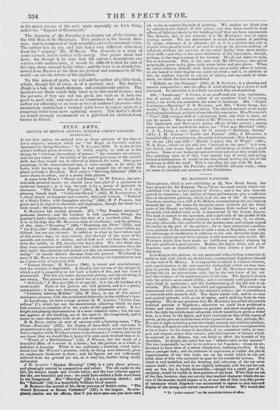MR. HAYDON'S NAPOLEON.
Tins picture, which is now exhibiting at 23, New Bond Street, has been painted for Sir ROBERT PEEL,* from the small sketch which was exhibited with the artist's picture of Elides; and it has also been engraved in mezzotint ; but neither of these performances give a sufficient
idea of the present painting, which is of the size of life. It represents Napoleon standing on a cliff of St. Helena, contemplating the sun sinking beneath the sea. He wears his favourite green uniform (of the Chas sears of the Guard, we believe), and his famous little cocked hat ; and
he stands with folded arms, as he is represented in the bronze figures. his back is turned to the spectator, and a part only of the profile of his face is visible. This, though contrary to the rules of art, is, we think;
not only allowable, but preferable in the present case, and evinces a good discretion on the part of the painter ; for to have attempted a posthumous portrait of the countenance of such a man as Napoleon, even with the advantage of recollection in addition to the aids derivable from the numerous paintings and busts extant, would have been only to fail. Mr.
Aynom might then have made an indifferent portrait ; whereas he has now produced a good picture. Besides, the figure, dress, and air of Napoleon were so remarkable, that they form almost a part of his character.
In looking at this picture, we are impressed with a feeling somewhat similar to that with which we should have contemplated Napoleon himself on the rock of St. Helena. It is impossible to behold it without interest, and a participation in the retrospective melancholy which we may ima
gine to possess the fallen hero himself. And Mr. HAYGOK has acc orn
plished this by no meretricious aids, but by the very force of his art and the vividness of his representation of the man. The figure is drawn with the artist's accustomed ability, and is extremely well painted—the right thighs in particular; and the foreshortening of the left foot is admirable. The effect also is beautiful and appropriate. The costume is represented with truth, even to the minutest points; the vraisemblance is conveyed with masterly skill. The figure stands well, and in an easy and natural attitude, with an air of repose, and is striking from its very
simplicity. We do not question that Mr. HATBOX has seized the precise habitual attitude of Napoleon ; otherwise we could have preferred a firmer and more decisive station—a grander and more energetic pose,
with the right leg a little more advanced, which would have given a wider base, as it were, to the figure, and have conveyed an idea of the repose of power, as the present attitude does of the repose of ease. But, perhaps, Mr.
H Alt DON is right in having given the simply natural and ordinary position.
The form of Napoleon looks more broad and muscular than we suppose him to have been ; for his frame is described, if we remember right, as com pact and elegant rather than robust ; and that increase of fatness which he acquired at St. Helena, was not likely to affect the breadth of his shoulders. In height the artist has not " added a cubit to his stature." The face is decidedly too fair in its paleness for Napoleon ; whom we un derstand to have been of a sallow complexion, inclining to olive. It has also a younger look ; and its calmness of expression is rather the placid ingenuousness of one who looks out on the world which he has not tried, than of him who attracted its gaze by his wonderful actions. The cheek is well modelled, and the drawing and colouring of the ear seem nature itself; but the brow is too slightly indicated, and the eye has not only no fire, but is hardly discernible,—though but a small part of it, certainly, would be visible in that position of the head. What little we see of the face, however, does not convey that marked character which the ac•
tion of the muscles would impart to it, or any idea of that iron-like power of resistance which Napoleon was accustomed to oppose to any outward display of the strong and varied emotions of his breast. We would also
• To "point a moral" on the uncertain tenure at office.
point out one or two minor objections, winch may easily be removed,— such, for instance, as the heavy appearance of the epaulettes, which stop the eye as it peruses the figure; and that awkward corner of the cuff under the arm, and the want of relief in the collar. In a picture of this kind, which depends upon a combination of minute points of resemblance, to impress the imagination by its reality, the smallest particular becomes of importance. The calm of the sea and sky is in good keeping, and the effect of the picture as a whole is beautiful. An improvement might be made in the colouring of the sea.



























 Previous page
Previous page